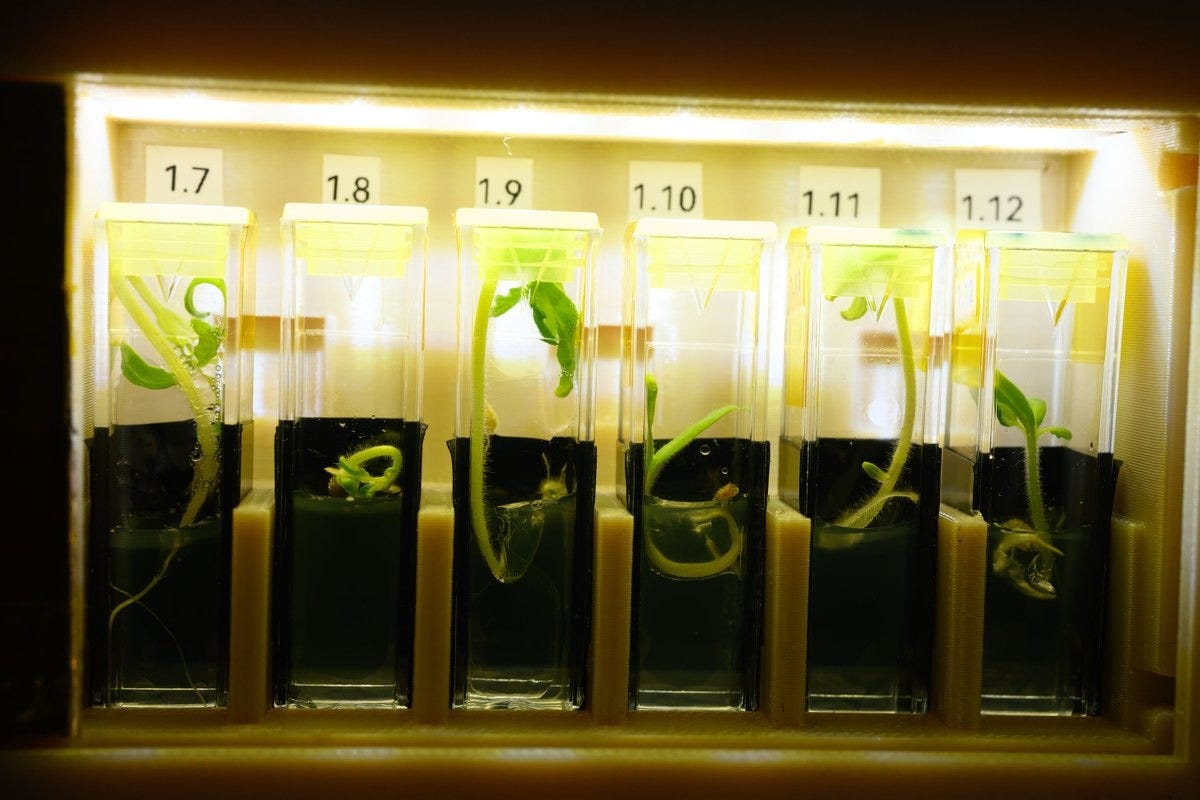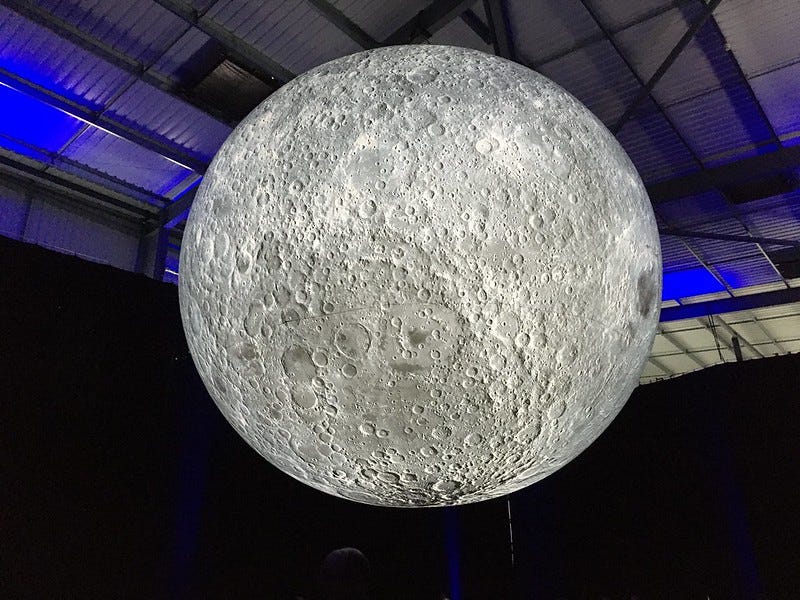Gardeners of the Galaxy Mission Report: 27 May 2025
My Top 10 Stories from the world of space plants and gardening. This week we've got space chiles, Moon roses, extraterrestrial dandelions and a space garden in Venice. Plus I saw the Moon!
Hello, Gardeners of the Galaxy! Welcome to this week's Mission Report.

1: Jacob Pepperseed

As I mentioned recently, NASA isn’t currently accepting proposals to use the Advanced Plant Habitat (APH) for experiments on the International Space Station (ISS), due to “recent resource constraints”. I don’t have any more details on that, but it’s a bit of a blow to Jacob Torres (our Mission Specialist for episode 24).
At NASA, Jacob worked on the amazingly successful PH-04 experiment, which grew the first chiles in space, and was part of the team that selected the variety grown - NuMex Española Improved. As an Española native, Jacob wanted to preserve local traditions, including spelling chile with an e, and harvesting both green and red peppers. He took on the role of “Jacob Pepperseed”, distributing chile seeds around the globe to teach children about astrobotany, a passion he still pursues today.
Jacob is now doing a PhD in mechanical engineering at the University of New Mexico. He has developed a passive irrigation system that he was hoping to test in space with the Advanced Plant Habitat.
Fingers crossed that the restrictions are lifted, or that Jacob finds another way to make his dream a reality.
Read more: New Mexico chiles earthbound after research on plants in space trimmed
2: Little Prince
Interstellar Lab announced Mission Little Prince in 2023, named after the classic children’s story by Antoine de Saint-Exupéry. The plan is to grow roses on the Moon to inspire a new generation to explore the universe. Interstellar Lab is committed to bringing life beyond Earth by growing flowers in space and capturing data and images that will pave the way for a new era of space exploration. They are collaborating with Meilland International to select the most suitable rose variety for the mission, and to study how the plant adapts when grown in low-gravity environments.
3: PWM

In 2021, a new series of experiments began on the ISS, exploring the complex way that water behaves in microgravity that makes watering space plants a challenge. The Plant Water Management (PWM) series (its PI, Mark Weislogel was our mission specialist for episode 29) is continuing with PWM-5 and -6, testing parameters such as gas and liquid flow rates, fill levels, inlet/outlet configurations, new bubble separation methods, serial and parallel flows, and new plant root types.
The PWM-5 and -6 hardware replaces the gravity with surface tension, wetting, and system geometry, creating a passive watering system with no moving parts. However, the tests don’t involve real plants, so future tests will need to incorporate those to see how they fare.
Read more: Unearthly Plumbing Required for Plant Watering in Space
4: Space-flown cherry blossom
Space-flown cherry seeds are being planted in Southwest China’s Yunnan Province. 200 grams (1,800 seeds) of wild Himalayan cherry, also known as the Yunnan winter cherry blossoms, took a trip into space on the Shijian-19 satellite in autumn last year. The goal is to develop one or two new varieties from the resulting plants, which are the only ornamental cherry blossom species in Yunnan that blooms in winter.
Read more: Cherry blossom seeds traveled in space start to sow in Southwest China’s Yunnan Province
5: Microgravity radishes
Students from Central Alabama Community College are sending radishes into space with Student Spaceflight Experiments Program (SSEP) Mission 20. Their experiment, which focuses on the early development of radish roots and shoots in space, is due to launch to the ISS in April 2026.
Read more: CACC Microgravity Experiment Selected for Spaceflight
6: Dandelion’s Odyssey
In Tokyo-born director Momoko Seto’s latest film, Dandelion’s Odyssey, four dandelion seeds escape from a succession of nuclear explosions to find themselves hurled into the cosmos, travelling through planets and constellations. When they land on an unknown land, they set off on an adventure to find a new home and settle for good.
Read more: Flower Power: ‘Dandelion’s Odyssey’ Director Momoko Seto Discusses Her Emotional Animated Adventure
7: A space garden in Venice
Among the more speculative contributions to the 2025 Venice Architecture Biennale’s main exhibition, Heatherwick Studio’s Space Garden imagines a celestial prototype for an autonomous, orbiting greenhouse. The project challenges our perceptions of space and sustainability, considering how cosmic agriculture can be humanised and harnessed through biophilic space design to enhance life on Earth.
“Space Garden started as an experiment in humanising space, by growing the plant species that make small spaces work better for your mental health,” says Thomas Heatherwick, “but ultimately, it’s also about using the unique ‘backyard’ of low Earth orbit to benefit life on our planet.”
Read more: Space garden proposes an orbiting greenhouse at Venice biennale
8: I saw the whole of the Moon!
Photograph of Luke Jerram’s artwork ‘Museum of the Moon’. Measuring seven metres in diameter, the moon features 120dpi detailed NASA imagery of the lunar surface. At an approximate scale of 1:500,000, each centimetre of the internally lit spherical sculpture represents 5km of the moon’s surface. The photo was taken while the piece was on display at Harwell Science Campus in Oxfordshire, UK.
Learn more: https://my-moon.org/
9: Plant-based vaccines
Aramis Biotechnologies is pioneering a new era of vaccine manufacturing using Nicotiana benthamiana, a wild tobacco plant known for its ability to rapidly produce high levels of proteins. While traditional vaccine production relies on cell cultures or chicken eggs, this innovative approach harnesses the natural protein-producing power of plants.
Read more: Vegan Vaccines Take Root: Inside Aramis Biotechnologies’ Plant-Based Revolution
10: Chaos Gardening
Chaos gardening is the ultimate plant-lover’s rebellion. It’s low-stakes, low-structure, and high-surprise—perfect for gardeners who crave creativity over control. By scattering seeds or tucking plants in overlooked spaces, growers often discover new, more sustainable ways to cultivate food. It’s also a celebration of adaptability. Culinary plants like mint, thyme, and garlic can thrive in unique microclimates or unconventional containers.
Read more: https://www.popsci.com/environment/chaos-gardening-vegetables-edibles-culinary-plants/
Don’t forget that I regularly post fresh content to my Space Botany website. I'll be back in your inboxes next week. Thanks for reading and being part of the Gardeners of the Galaxy community.
Ex solo ad astra,
Emma (Space Gardener)





